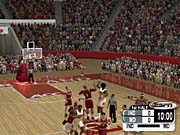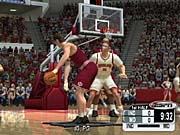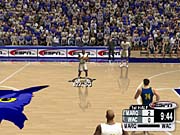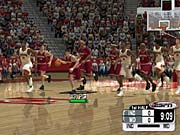Though they're ostensibly the same sport, college and professional basketball can be quite different from each other. From the variety of zone defenses to the generally more mechanical (and practical) movement of the ball on offense, college basketball tends to be a little slower and more methodical than the professional version of the sport, emphasizing fundamentals over flash. Sega's NCAA College Basketball 2K3 admirably attempts to mimic college basketball, and in some cases, it's successful in doing so. But the game still has a few rough spots on both the offensive and defensive sides of the ball that would make any fan of the sport throw his or her controller in frustration.

If there's one area where NCAA College Basketball 2K3 shows absolutely no sign of weakness, it's in the number and depth of the playable modes that are available. The game features the usual season and exhibition options, in which you can play through an entire season of college basketball or just one game, respectively, but it also features a great custom tournament mode in which you can create a tournament for any of the 30 conferences or all of the NCAA, a practice mode to help you become familiar with the fundamentals, a gym rat option that is comparable to the street ball mode in NBA 2K3, and a legacy mode. NCAA Basketball 2K3 also features online multiplayer support through Xbox Live, and it works quite well. Like in NBA 2K3, you can view win-loss records for every player online and create your own game or instantly join one. We played a number of games online, and we didn't experience much lag, though the game did bog down on a few occasions.
Most college basketball fans will initially be content with the tournament mode, but the legacy mode is what will bring them back to the game long after it's been purchased. There are two different types of approaches in the legacy mode, open and career. With the open option, every team has an open coaching spot right off the bat, so any one of them is immediately selectable. However, in the career option, most of the teams are locked and you'll be forced to start at one of the lower-tier basketball programs and meet a certain requirement to consider your season successful. If you meet that goal (which can be something as simple as winning half the games that season), then you might get job offers from other schools. If you don't, you'll have to stick it out with the same school for another season. It can be an incredibly fun mode to play through, and one that would've provided substantial motivation for continually playing through the legacy mode, but much of that is taken away by the fact that you can just go ahead and select any team in the open option.

In any case, at the end of a season in legacy mode, a number of players will either graduate or move on to the NBA, so those holes in your lineup have to be filled by recruiting high school players. When the recruiting screen opens up, you'll see a list of players and their overall rating, their position, and the top three schools they're interested in. You can attempt to recruit any one of these players by spending recruiting points and having either the head coach or an assistant coach give that particular player a call to find out more about his abilities and the type of school he wants to attend. If he does show signs of interest, you can follow up the phone call with an actual visit by the coach so his interest remains intact. There are quite a few things to pay attention to in the recruiting process, but one of the keys is to at least go after a player who is already somewhat interested in playing for your school.
Since the gameplay mechanics in NCAA College Basketball 2K3 are essentially sound, all these modes are quite successful in adding some depth to the game, but there are some lingering problems that will pop up over the course of a season or even a single game, particularly against a computer opponent. Perhaps the game's biggest problem on the offensive side of the ball is the speed and accuracy, or lack thereof, in the passing game. Most colleges play a variety of zone defenses, and in order to break down those defenses, you need quick passes around the perimeter, but the passing in the game can be too slow, giving the defenders far too much time to adjust their defense and send a double team out on the ball handler. The analog passing seems to alleviate this problem somewhat, but the lack of speed is still readily apparent. In addition, it's a little too easy to intercept passes by sticking a man in the passing lane, though this encourages you to avoid poor passes.
The other issues on the offensive side of the ball deal directly with the fast break and the post-up game. It's incredibly difficult to get an open fast break in NCAA 2K3, simply because a computer opponent will almost always run by the player with the ball and block his path to the basket. Obviously, fast breaks aren't as common as they are in the NBA, but the only time a fast break ever seems to really work is under incredibly special circumstances, such as when the computer dives for a loose ball and your point guard or shooting guard grabs the ball right at the half-court line, so be prepared to focus on the half-court set. As for the post-up game, it's not horrible by any means, but again the passing can come into play. When you throw the ball down to a man on the block, he'll almost always draw a double team from the zone defense that the opponent is running, making it very difficult to even perform a simple drop-step move. Obviously, you could have the post-up man pass the ball back out to a man on the perimeter so he can draw the defense, and then have the perimeter man throw it back in for a reset, but again the passing is too slow and the defense is far too quick for this to work effectively most of the time. When the computer or a human-controlled opponent runs a man-to-man defense, these problems are much less prevalent, but the zone defense is the primary option for most teams.

The defensive side of the ball has its own irritating problems, the first of which is rebounding. Even with the rebounding option set to the equivalent of high, players will occasionally just stand around when a ball drops right in front of their faces, allowing the opponent to get the offensive rebound and another chance to score. Also, if you're not particularly familiar with each version of the zone defense, then you may be causing your team more harm than good because the player you're controlling might be out of place. NCAA College Basketball 2K3 offers a role-player option that lets you take control of a single player throughout the entire game, which can help alleviate the problem of playing out of position, since you can only move one player around the court or you can just switch the defense to man-to-man.
The Xbox version of the game is predictably better looking than its PlayStation 2 and GameCube counterparts, but it still falls short of the visual quality of NBA 2K3. Though most of the character models are fairly generic, they're still relatively detailed and feature some of the visual trademarks of college basketball such as players who wear T-shirts under their jerseys. From the banners in the rafters to the styles of the floors, almost all the arenas in the game look great, and graduates of the schools in NCAA 2K3 should be able to recognize them almost immediately. There are also some nice little touches in the crowd, such as cheerleaders and student sections that will hold up individual cards to spell the school name.

Likewise, the stadium noise in NCAA 2K3 is great, as you'll hear not only team-specific cheers but also many of the chants meant to rattle the opposing team. The commentary in the game is solid, for the most part, and it sounds natural when the play-by-play man and the color commentator interact with each other, but the team does have the tendency to repeat itself, and in some cases the play-by-play man can't quite keep up with the action onscreen.
NCAA College Basketball 2K3 is a solid game with plenty of modes to choose from, but it ultimately falls short of being an accurate simulation of college basketball. The passing system is far too slow and imprecise to break down the zone defenses effectively, even when running plays. This also affects the post-up game, which is almost rendered useless for anything but a pull-up jumper. Casual fans probably won't notice such problems, but the hard-core college basketball fan will more than likely be frustrated with them.